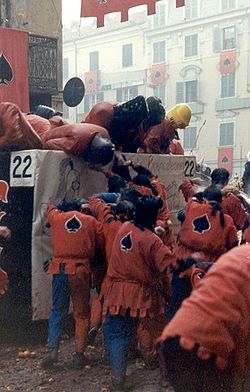
Battle of the Oranges
Encyclopedia

Carnival
Carnaval is a festive season which occurs immediately before Lent; the main events are usually during February. Carnaval typically involves a public celebration or parade combining some elements of a circus, mask and public street party...
and festival in the Northern Italian city of Ivrea
Ivrea
Ivrea is a town and comune of the province of Turin in the Piedmont region of northwestern Italy. Situated on the road leading to the Aosta Valley , it straddles the Dora Baltea and is regarded as the centre of the Canavese area. Ivrea lies in a basin that, in prehistoric times, formed a great lake...
, which includes a tradition of throwing of oranges between organized groups. It is the largest food fight
Food fight
A food fight is a form of chaotic collective behavior, in which food is thrown at others in the manner of projectiles. These projectiles are not made to harm or damage others, but to simply ignite a fight filled with spontaneous food throwing. Food fights may be impromptu examples of rebellion or...
in Italy.
History of festival
The festival's origins are somewhat unclear. A popular account has it that it commemorates the city's defiance against the city's tyrant, who is either a member of the Ranieri family or a conflation of the 12th-century and the 13th-century Marquis William VII of Montferrat. This tyrant attempted to rape a young commoner (often specified as a miller's daughter) on the eve of her wedding, supposedly exercising the (possibly fictional) droit de seigneurDroit de seigneur
Droit du seigneur is an alleged legal right allowing the lord of a medieval estate to take the virginity of his serfs' maiden daughters. There is no historical evidence that such a right ever existed.-Terminology:...
. His plan backfired when the young woman instead decapitated the tyrant, after which the populace stormed and burned the palace. Each year, a young girl is chosen to play the part of Violetta, the defiant young woman.
Every year the citizens remember their liberation with the Battle of the Oranges where teams of "Aranceri" (orange handlers) on foot throw oranges (representing ancient arrows and stones) against Aranceri riding in carts, representing Arduino's allies. During the 19th-century French occupation of Italy the Carnival of Ivrea was modified to add representatives of the French army who help the miller's wife.
The carnival may have started in the 12th century and also includes a large bonfire
Bonfire
A bonfire is a controlled outdoor fire used for informal disposal of burnable waste material or as part of a celebration. Celebratory bonfires are typically designed to burn quickly and may be very large...
.
Celebration
The core celebration is based on a locally famous Battle of the Oranges that involves some thousands of townspeople, divided into nine combat teams, who throw oranges at each other – with considerable violence – during the traditional carnival days: Sunday, Monday and Tuesday. The carnival takes place in February: it ends on the night of "Fat Tuesday" with a solemn funeral. Traditionally, at the end of the silent march that closes the carnival the "General" says goodbye to everyone with the classical phrase in dialect "", translated as "we'll see each other on Thursday at one", referring to the Thursday the carnival will start the next year.Miller's daughter
One of the citizens is elected Mugnaia. Legend has it that a miller's daughter (a "Mugnaia") once refused to accept the "right" of the local duke to spend a night with each newly wed woman and chopped his head off. Today the carriages represent the duke's guard and the orange throwers the revolutionaries. Spectators are not allowed to throw oranges, but visitors are allowed to enlist in the teams. If they wear a red hat they are considered part of the revolutionaries and will not have oranges thrown at them.Originally beans were thrown, then apples. Later, in the 19th century, oranges came to represent the duke's chopped off head. The origin of the tradition to throw oranges is not well understood, particularly as oranges do not grow in the foothills of the Italian Alps and must be imported from Sicily. In 1994 an estimated 265000 kilograms (584,225 lb) of oranges were brought to the city, mainly coming from the leftovers of the winter crop in southern Italy.
See also
- La Tomatina, Spain's battle of the tomatoes
- Book of Judith, a deuterocanonicalDeuterocanonical booksDeuterocanonical books is a term used since the sixteenth century in the Catholic Church and Eastern Christianity to describe certain books and passages of the Christian Old Testament that are not part of the Hebrew Bible. The term is used in contrast to the protocanonical books, which are...
story of a young woman who, threatened with rape, decapitates her rapist
External links
- Battaglia delle arance – Orange Battle - part of the carnival's official website
- the nine teams of Aranceri a piedi
- Italians battle with oranges on Valentines day 15 February 2010 BBC News, 1 minute 25 second video
- Italy hosts 'Battle of the Oranges' 23 February 2009 BBC News, 51 second video

